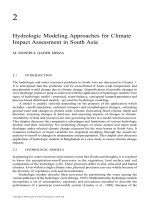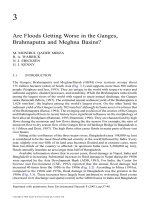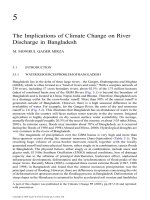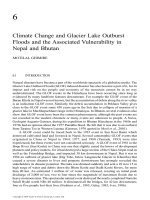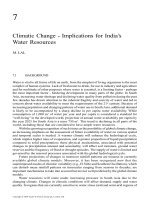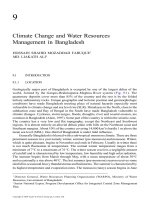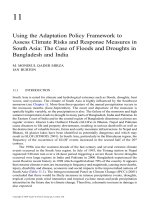Climate Change and Global Food Security - Section 3 ppt
Bạn đang xem bản rút gọn của tài liệu. Xem và tải ngay bản đầy đủ của tài liệu tại đây (1.49 MB, 162 trang )
Section III
Climate Change and
Agronomic Production
© 2005 by Taylor & Francis Group, LLC
243
10
Climate Change, Agriculture, and
Sustainability
CYNTHIA ROSENZWEIG AND DANIEL HILLEL
CONTENTS
10.1 Climate Change 245
10.2 Goals of Impact Studies 247
10.3 Agro-Ecosystem Processes 247
10.4 What We Have Learned 249
10.4.1 Agriculture Regions Will Experience
Change over Time 249
10.4.2 Effects on Agricultural Production
Systems Will Be Heterogeneous 251
10.4.3 Agricultural Production in Many
Developing Countries Is Especially
Vulnerable 251
10.4.4 Long-Term Effects on Agriculture
Are Negative 253
10.4.5 Agricultural Systems Can Adapt, but
Not Completely 253
© 2005 by Taylor & Francis Group, LLC
244 Rosenzweig and Hillel
10.5 Key Interactions 254
10.5.1 El Niño-Southern Oscillation 254
10.5.2 Water Resources 256
10.5.3 Agricultural Pests 256
10.6 Mitigation and Adaptation Responses 258
10.6.1 Mitigation 259
10.6.2 Adaptation 260
10.7 Interactions 262
10.7.1 Research Pathways 263
10.7.1.1 Climate Variability and Change 263
10.7.1.2 Observed Effects of
Warming Trends 264
10.7.1.3 Global and Local Scales 265
10.8 Conclusion 266
References 266
The first global climate model experiments projecting the atmo-
spheric responses of increasing carbon dioxide (CO
2
) and other
greenhouse gases were published in the early 1980s. Soon after,
research began on the agricultural implications of the changing
atmospheric composition and its projected climate shifts. As
the primary land-based human activity most intimately con-
nected with climate and as the very foundation for human
nutrition and indeed survival, agriculture naturally became a
key focus for early climate change impact studies.
Through the ensuing two decades, scientists have
employed a variety of analytic approaches in a multitude of
studies to answer such research questions as: What might be
the major effects of climate changes in the 21st century? Are
some regions likely to gain, while others lose? What response
measures are indicated? How climate change affects agricul-
ture and how agriculture responds to a changing climate will
invariably shape the sustainability of this vital sector.
Research in the area of climate change impacts on agricul-
ture has involved field experiments, regression analyses, and
modeling studies. The fields concerned have included agronomy,
resource economics, and geography. Climate change and
© 2005 by Taylor & Francis Group, LLC
Climate Change, Agriculture, and Sustainability 245
agriculture studies continue, with broad-brush explorations giv-
ing way to more detailed studies of biophysical processes and
social responses. In this chapter, we review some of the main
lessons learned from two decades of research on climate change
and agriculture, and then delineate several pathways for con-
tinuing research that will help to elucidate further the interac-
tions of climate change and agricultural sustainability.
10.1 CLIMATE CHANGE
Climate change projections are fraught with much uncer-
tainty in regard to both the rate and magnitude of tempera-
ture and precipitation alterations in the coming decades. This
uncertainty derives from a lack of precise knowledge of how
climate system processes will change and of how population
growth, economic and technological development, and land
use will proceed in the coming century (Intergovernmental
Panel on Climate Change [IPCC], 2000, 2001).
Nevertheless, three points regarding climate change can
gas concentrations have increased progressively since the
beginning of the Industrial Revolution. Second, the natural
presence of greenhouse gases is known to affect the planetary
energy balance, causing the planet to be warmer than it would
be otherwise. Thus, any increases in greenhouse gases will
tend to enhance the natural “greenhouse effect.” Third, the
planet has indeed been warming over the last century, espe-
cially in the most recent two and a half decades.
The IPCC has attributed the observed warming over the
last century to anthropogenic emissions of greenhouse gases,
especially carbon dioxide (CO
2
), methane (CH
4
), and nitrous
oxide (N
2
O) (IPCC, 2001). Thus, anthropogenic emissions of
greenhouse gases appear to be altering our planetary energy
balance and to be manifested in a large-scale warming of the
planet. If warming continues at the global scale, the associa-
tion among greenhouse gas emissions, greenhouse effect, and
surface warming will trend toward greater and greater cer-
tainty. The ultimate significance of the climate change issue
is related to its planetary scale.
© 2005 by Taylor & Francis Group, LLC
be made with some certainty (Figure 10.1). First, greenhouse
246 Rosenzweig and Hillel
Some of the infrared
radiation passes through
the atmosphere, and some
is absorbed ane re-emitted
in all directions by
greenhouse gas
molecules. The effect of
this is to warm the Earth's
surface and the lower
atmosphere.
Some solar radiation
is reflected by the
Earth and the
atmosphere.
Solar radiation
passes through
the clear
atmosphere
SUN
EARTH
ATMOSPHERE
Most radiation is
absorbed by the Earth's
surface and warms it.
Infrared radiation is
emitted from the
Earth's surface.
Carbon Dioxide Concentrations
A
C
B
Ice Core Data
Mauna Loa
(Hawaii)
290
300
310
320
330
340
350
360
370
1860 1880 1900 1920 1940 1960 1980 2000
parts per million
Global Average Temperature
CF
13.5
13.6
13.7
13.8
13.9
14.0
14.1
14.2
14.3
14.4
1860 1880 1900 1920 1940 1960 1980 2000
56.30
56.48
56.66
56.84
57.02
57.20
57.38
57.56
57.74
57.92
5 year average
© 2005 by Taylor & Francis Group, LLC
Climate Change, Agriculture, and Sustainability 247
10.2 GOALS OF IMPACT STUDIES
Many of the climate change studies done to date, particularly
the early ones, were undertaken to aid national policymakers
to assess the significance of global climate change and its
implications for broad regions as well as for whole countries.
These studies are thus “policy relevant” in the sense that they
may contribute to national decisions on whether and how to
participate in the U.N. Framework Convention on Climate
Change (UNFCCC) and the Kyoto Protocol. Questions here
revolve around how serious the ultimate warming may be;
who may be the “winners and losers”; and what the potential
is for adaptation in broad-brush terms.
Recently, attention has been turning to how to respond
to global climate change, including more detailed explorations
of adaptation strategies and adaptive capacities at finer spa-
tial scales — even down to individual villages. Many of these
adaptation studies are focused on defining vulnerability and
represent a link between the experience of current climate
extremes, disaster management, and potential decadal-to-
century warming. A further shift in focus involves the poten-
tial role of carbon sequestration in climate change mitigation,
and to what extent this can reduce the anthropogenic build-
up of greenhouse gases in the atmosphere.
10.3 AGRO-ECOSYSTEM PROCESSES
Determining what the net effect of a changing climate may
be on an agro-ecosystem is complicated due to the interactions
of several simultaneous biophysical processes. In some cases,
changes in climate may be beneficial, while in others they
Figure 10.1 (opposite page) The three certainties of global cli-
mate change: (A) the greenhouse effect and planetary energy bal-
ance; (B) atmospheric concentrations of greenhouse gases, 1860 to
present; and (C) mean global surface temperature, 1860 to present.
(From OSTP. 1997. Climate Change: State of Knowledge. Office of
Science and Technology Policy, Washington, DC.)
© 2005 by Taylor & Francis Group, LLC
may be detrimental (Figure 10.2). On the beneficial side,
248 Rosenzweig and Hillel
increasing levels of atmospheric CO
2
have been shown to
increase photosynthesis rates and to increase stomatal resis-
tance in crops, leading to overall increased water-use
efficiency (Kimball et al., 2002). These processes have been
called “CO
2
fertilization.”
Another beneficial impact would be the prolongation of
crop growing seasons in areas where they are now limited by
cold temperature, that is, at high latitudes and high eleva-
tions. A further benefit for crops may accrue in some semi-
arid locations from increased precipitation, since a warmer
atmosphere can hold more water vapor. However, the location
and extent of any such regions of enhanced precipitation is
not known precisely, due primarily to the difficulty of simu-
lating the regional-scale hydrological cycle in global climate
models.
A warmer and more variable climate is likely to have
negative as well as positive effects on agricultural regions
around the world. Potential negative effects include more
frequent droughts and floods, heat stress, increased outbreaks
of diseases and pests, shortening of crop growing periods, and
— in coastal regions — increased flooding and salination due
to sea-level rise and impeded drainage. While the absolute
Figure 10.2 Agro-ecosystem processes and a changing climate.
(Redrawn from Bongaarts, J. 1994. Sci. Am., 270:36–42.)
Carbon dioxide
fertilization
Longer
growing
season
Increased
precipitation
Faster
growing
periods
Pest
Heat
stress
Increased
flooding and
salinization
More
frequent
droughts
CO
2
Possible benefits
Possible drawbacks
© 2005 by Taylor & Francis Group, LLC
Climate Change, Agriculture, and Sustainability 249
magnitude of precipitation change in any one region or decade
is not predictable, global climate models project that hydro-
logical regimes are likely to become more intense as well as
more variable (IPCC, 2001). Episodes of heat stress are known
to be detrimental to crops, especially during critical growth
stages, and such episodes are likely to be more frequent and
prolonged in the future.
An important, albeit counterintuitive, negative effect
that warming has on crops is the shortening of their growing
period (not their overall growing season). Warmer tempera-
tures speed crops through their growing cycle, especially the
grain-filling stage. Total yield is a product of the rate and
duration of grain filling, which is determined by accumulated
temperature. Since higher temperatures shorten the duration
of grain filling, higher temperature tends to exert a negative
pressure on the yield of most annual crops.
Finally, in agricultural regions close to the ocean, sea-
level rise and associated saltwater intrusion and flooding can
harm crops through impeded soil aeration and salination.
This is likely to be most serious in countries such as Egypt
and Bangladesh, which have major crop-growing areas in low-
lying coastal regions.
10.4 WHAT WE HAVE LEARNED
10.4.1 Agriculture Regions Will Experience
Change over Time
Due to all the agro-ecosystem processes described above, it is
fairly certain that agricultural regions will experience some
changes, and that these changes will evolve continuously
through the coming decades. Shifts in crop zonation are likely
to occur, with some crop types expanding their ranges and
others contracting. Given the range of projected temperature
and precipitation changes from global climate models, and the
unknown degree of manifestation of direct CO
2
effects on
crops growing in farmers’ fields, however, the magnitudes and
rates of these changes are uncertain.
© 2005 by Taylor & Francis Group, LLC
250 Rosenzweig and Hillel
The interactions between beneficial and detrimental
agro-ecosystem processes are likely to change over time for
several reasons. First, as biophysical responses move through
their temperature–response curves, responses to change in
temperature may shift from positive to neutral, and then to
negative (Figure 10.3). Another reason that climate change
effects are likely to be transformed over time is the potential
for decadal shifts in the hydrological cycle. While it is difficult
to predict the direction of change in any specific agricultural
region, global climate models do show increased decadal vari-
ability in hydrological regimes. Finally, as crop breeding and
pest species evolve in the coming decades under changing
climate conditions, new agro-ecosystem weeds, insects, and
diseases are likely to emerge, and the adjustment to these
may be costly.
Figure 10.3 Temperature response curve for biological processes.
(From Rosenzweig, C., and D. Hillel. 1998. Climate Change and the
Global Harvest: Potential Impacts of the Greenhouse Effect on Agri-
culture. Oxford University Press, New York. With permission.)
T
opt
T
max
T
min
Temperature
Plant growth rate
© 2005 by Taylor & Francis Group, LLC
Climate Change, Agriculture, and Sustainability 251
10.4.2 Effects on Agricultural Production
Systems Will Be Heterogeneous
Global studies done to date show that negative and positive
effects will occur both within countries and across the world.
In large countries such as the United States, Russia, Brazil,
and Australia, agricultural regions will likely be affected quite
differently (Figure 10.4). Some regions will experience
increases in production and some declines (e.g., Reilly et al.,
2003). At the international level, this implies possible shifts
in comparative advantage for export crop production. This
also implies that adaptive responses to climate change will
necessarily be complex and varied.
10.4.3 Agricultural Production in Many
Developing Countries Is Especially
Vulnerable
Despite general uncertainties about the rate and magnitude of
climate change and about consequent hydrological changes,
regional and global studies have consistently shown that
Figure 10.4 Simulated percentage changes in U.S. regional agri-
cultural production, with adaptation, under the Canadian Climate
Center scenario. (From Reilly, J., F. Tubiello, B. McCarl, et al. 2003.
Climatic Change, 57:43–69. With permission.)
Index, 0=no change
Northeast
Lake
states
Cornbelt
North
plains
Southeast Delta
South
plains
Mountain Pacific
Appalachian
2030 2030 w/adapt
2090 2090 w/adapt
100
80
60
40
20
0
-20
-40
-60
-80
© 2005 by Taylor & Francis Group, LLC
252 Rosenzweig and Hillel
agricultural production systems in the mid and high latitudes
are more likely to benefit in the near term (to mid-century),
while production systems in the low latitudes are more likely
to decline (IPCC, 2001). In biophysical terms, rising tempera-
tures will likely push many crops beyond their limits of optimal
growth and yield. Higher temperatures will create more
atmospheric water demand leading to greater water stress,
especially in semi-arid regions. Since most of the developing
countries are located in lower-latitude regions, while most devel-
oped countries are located in the mid- to high-latitude regions,
this finding suggests a divergence in vulnerability between
these groups of nations, with far-reaching implications for
future world food security (Table 10.1) (Parry et al., 2004).
Furthermore, developing countries often have fewer
resources with which to devise appropriate adaptation mea-
sures to meet changing agricultural conditions. The combina-
tion of potentially greater climate stresses and low adaptive
capacity in developing countries creates different degrees of
vulnerability as rich and poor nations confront global warm-
ing. This differential is due in part to the potentially greater
detrimental impacts of a changing climate in areas that are
already warm, and in part to the generally lower levels of
adaptive capacity in developing countries. The latter tend to
be food-recipient countries in times of food crises, while devel-
oped countries are more often donors.
Table 10.1 Effects of Climate Change on Global Food Production
Under Various Scenarios (Percent Change in Yield)
HadCM3 2080s
HadCM2
2080s
Scenario A1F1 A2a A2b A2c B1a B2a B2b S550 S750
CO
2
ppm 810 709 709 709 527 561 561 498 577
World –5 0 0 –1 –3 –1 –2 –1 1
Developed countries 3 8 6 7365 5 7
Developing countries –7 –2 –2 –3 –4 –3 –5 –2 –1
Developed countries–
developing countries
differences
10.4 9.8 8.4 10.2 7.0 8.7 9.3 6.6 7.7
© 2005 by Taylor & Francis Group, LLC
Climate Change, Agriculture, and Sustainability 253
10.4.4 Long-Term Effects on Agriculture Are
Negative
If the effects of climate change are not abated, even production
in the mid- and high-latitude regions is likely to decline in
the long term (end of 21st century) (Figure 10.5). These
results are consistent over a range of temperature, precipita-
tion, and direct CO
2
effects tested, and are due primarily to
the detrimental effects of heat and water stress as tempera-
tures rise. While the beneficial effects of CO
2
will eventually
level out, the detrimental effects of warmer temperatures and
greater water stress will be progressive in all regions.
10.4.5 Agricultural Systems Can Adapt, but Not
Completely
Adaptation is integral to the study of climate change impacts
on agriculture. Social scientists have made a significant con-
tribution to the field of climate change impacts by bringing
forward this important point (IPCC, 2001; Smith et al., 2003).
Figure 10.5 Generalized projection of world agricultural produc-
tion potential and areal extent under low and high CO
2
responses
for increasing severity of climate change. (Note: severity of climate
change may be taken as a proxy for decadal-to-century timeframe.)
(From Fischer, G., and F. Tubiello. Personal communication, 2003.)
120
110
100
90
80
0-10 = Severity of climate change (~time)
WORLD
Production potential low CO
2
response
Production potential high CO
2
response
Area extent assuming low CO
2
response
Area extent potential assuming high CO
2
response
01234 1056789
© 2005 by Taylor & Francis Group, LLC
254 Rosenzweig and Hillel
The task now is to integrate the findings and insights of
economists, sociologists, political scientists, anthropologists,
and psychologists in providing guidance to decision makers,
so as to promote sectoral and international cooperation in
minimizing the potential negative impacts and maximizing
the opportunities for adjustment to climate change.
10.5 KEY INTERACTIONS
We need to understand how interactions within a changing
climate will affect agriculture. (1) How will large-scale climate
variability systems such as the El Niño–Southern Oscillation
change? (2) How will supply and demand for water resources
be affected? (3) How will pests of crops and livestock — includ-
ing weeds, insects, and diseases — evolve?
10.5.1 El Niño-Southern Oscillation
The El Niño–Southern Oscillation (ENSO) is a large-scale
ocean–atmosphere, quasi-regular interaction in the Pacific
Ocean, which has reverberations in the climate system world-
wide. These climate “teleconnections” bring droughts and
floods to many agricultural regions, especially in the tropics,
but to some degree in mid-latitudes as well. During an El
Niño event, droughts tend to occur in Northeast Brazil, Aus-
tralia, Indonesia, and southern Africa, among other locations,
while floods tend to occur in southeastern South America, the
west coast of North America, and the Horn of Africa.
In the La Niña phase, the reverse tends to occur.
for southeastern South America under the plentiful rainfall
conditions of the El Niño in February 1998, and the severe
drought brought on by the opposite La Niña conditions in
February 2000. While it is uncertain exactly how a warming
climate will affect this major variability system, there is
potential for more frequent El Niño-like conditions that may
affect agricultural regions around the world (IPCC, 2001).
© 2005 by Taylor & Francis Group, LLC
Figure 10.6 shows the normalized difference vegetation index
Climate Change, Agriculture, and Sustainability 255
Figure 10.6 Effects of El Niño–Southern Oscillation on vegetation index in southeast South
America: El
Niño, February 1998; La Niña, February 2000. (From W. Baethgen, personal communication, 2003.)
February 2000February 1998
Grupo de Riego y
Agricultura Satelital
Grupo de Riego y
Agricultura Satelital
© 2005 by Taylor & Francis Group, LLC
256 Rosenzweig and Hillel
10.5.2 Water Resources
Both supply of and demand for water resources are likely to
change in a warming climate. As population increases and
urbanization proceeds apace, there is also likely to be greater
demand for water from competing domestic and commercial
users. Studies show that increased water requirements for
agriculture in many regions are likely under warming condi-
tions, and that there is potential for decadal “surprises” in
the reliability and percentage of water demand that can be
Research on water resources for agriculture in temperate
areas has shown that changes in seasonality such as earlier
snowmelt will likely change the filling and use of reservoirs
and hence of water availability for irrigation (Figure 10.7b)
(Strzepek et al., 1999). Current utilization plans for such
facilities will need to be adjusted and readjusted as the
decades proceed. Whereas early work on climate change
impacts on agriculture tended to focus on the effects of more
frequent droughts, recent work has emphasized the important
role of damage from floods and excess soil moisture as well
(Figure 10.7c) (Rosenzweig et al., 2002). Early decades in the
century may tend to be wetter and the later ones drier, due
to the greater effect of rising temperatures on evaporative
demand later in the century.
10.5.3 Agricultural Pests
Pest–crop interactions play a crucial role in agro-ecosystems.
Pest problems are very likely to be exacerbated under chang-
ing climate conditions since pests tend to thrive in warmer
conditions (Rosenzweig et al., 2001). This is due to the length-
ening of the frost-free seasons, allowing for more generations
of pests; the extension of overwintering ranges with warmer
winters; and the potential for new pests to emerge and
spread, such as has occurred with the soybean cyst nematode
and the soybean sudden death syndrome caused by Fusarium
mate, warmer temperature and increases in rainfall tend to
increase average per acre pesticide usage costs for many
© 2005 by Taylor & Francis Group, LLC
met (Figure 10.7a) (Strzepek et al., 1999; Doll, 2002).
solani f. sp. alycines (Figure 10.8). Even in the current cli-
Climate Change, Agriculture, and Sustainability 257
Figure 10.7 (A) Demand met (monthly average percentage of water demand
met) and reliability (percentage of years in which water demands are met) for the
Lower Missouri Water Region for the present and for the Max Planck (MPI) climate
change scenario for the 2010s, 2020s, and 2050s. (B) Runoff in the water regions
supplying the U.S. Cornbelt for current climate, and the Geophysical Fluid Dynamics
Laboratory, MPI, and Hadley Center (HC) climate change scenarios. (C) Number of
events causing damage to maize yields due to excess soil moisture conditions, aver-
aged over all study sites, under current baseline (1951–1998), and the HC and
Canadian Climate Centre climate change scenarios. Events causing a 20% simulated
yield damage are comparable to the 1993 U.S. Midwest floods. (From Strzepek, K.M.,
D.C. Major, C. Rosenzweig, A. Iglesias, D.N. Yates, A. Holt, and D. Hillel. 1999. J.
Am. Water Resour. Assoc., 35:1639–1655; and Rosenzweig, C., F.N. Tubiello, R. Gold-
berg, E. Mills, and J. Bloomfield. 2002. Global Environ. Change, 12:197–202. With
permission.)
0
400
20
40
60
80
100
1990
2000 2010 2020 2030 2040 2050
Year
Reliability
Demand met
Percentage
Runoff (cfs)
300
200
100
50
O
ND
J
F
M
A
MJ
J
A
S
Months
Current
GFDL
MPI
HC
510152025
% Change to yield
Baseline
HCGS 2030
CCGS 2030
HCGS 2090
CCGS 2090
Number of events
12
10
8
6
4
2
0
A
B
C
© 2005 by Taylor & Francis Group, LLC
258 Rosenzweig and Hillel
crops (Chen and McCarl, 2001). The emergence of new pests
could produce situations for which agricultural systems may
not be prepared.
10.6 MITIGATION AND ADAPTATION
RESPONSES
After nearly two decades of research on the potential impacts
of climate change on agriculture, attention is now turning to
Figure 10.8 Spread of agricultural pests under current climate
conditions: (top) Spread of soybean cyst nematode, 1971-1998; (bot-
tom) Spread of soybean sudden death syndrome. (From Rosenzweig,
C., A. Iglesias, X.B. Yang, P.R. Epstein, and E. Chivian. 2001. Global
Change Hum. Health, 2:90–104. With permission.)
1998
1993
1985
1971
19981973
© 2005 by Taylor & Francis Group, LLC
Climate Change, Agriculture, and Sustainability 259
the assessment of appropriate responses. A distinction can be
made between two types of responses: mitigation and adap-
tation. Mitigation is action to check the rising atmospheric
concentration of greenhouse gases, thereby moderating their
effects. Adaptation refers to actions that reduce the negative
effects or enhance the beneficial effects of climate changes
that are already occurring or are projected to occur in the
future. Adaptations may be either autonomous or planned
(IPCC, 2001). Research on these two types of responses have
proceeded on parallel tracks. Here we suggest that they be
considered conjunctively.
10.6.1 Mitigation
The practice of agriculture plays a major role in the global
Rosenzweig and Hillel, 2000). On a global scale, the process
of photosynthesis by agricultural crops fixes about 2 Gt C
year
–1
, with about 1 Gt C year
–1
providing sustenance for the
world’s population that is respired back to the atmosphere as
it is consumed; about 1 Gt C is returned to the soil annually
as plant residues. Some of the latter carbon, however, subse-
quently is returned to the atmosphere by soil microbial activ-
ity, and some is stored in the soil matrix. Furthermore, the
fossil fuel that powers the machinery to sow, irrigate, harvest,
and dry crops worldwide is responsible for atmospheric emis-
sions of about 150 MT (million metric tons) C year
−1
. Large
amounts of fossil fuel energy are used to produce fertilizers,
especially nitrogenous compounds. Rice cultivation, livestock
production, and soil processes are also responsible for consid-
erable methane and nitrous oxide emissions (Rosenzweig and
Hillel, 1998).
The agricultural carbon cycle offers several entry points
for mitigation of greenhouse gas accumulation in the atmo-
sphere. An important one is the potential for agricultural soils
to store carbon, particularly to the extent that its “active”
carbon stores had been depleted by past soil management
practices (Rosenzweig and Hillel, 2000). Other ways that agri-
culture may help to mitigate the enhanced greenhouse effect
© 2005 by Taylor & Francis Group, LLC
carbon cycle (Figure 10.9) (Rosenzweig and Tubiello, 2004;
260 Rosenzweig and Hillel
are through the production of biofuels, the development of
more efficient rice and livestock production systems, and the
reduction of fossil fuel use by farm machinery.
10.6.2 Adaptation
Farmers have always had to adapt to the vagaries of weather,
whether on weekly, seasonal, or annual timescales. They will
undoubtedly continue to adapt to the changing climate in the
coming decades, applying a variety of agronomic techniques,
such as adjusting the timing of planting and harvesting oper-
ations, substituting cultivars, and ultimately changing the
entire cropping system.
However, it is important to remember that farming sys-
tems have never been completely adapted even to the current
climate (witness the recurrent effects of droughts and floods on
various agricultural regions around the world). Hence, it seems
unreasonable to expect perfect adaptation in the future to
changing climate conditions. Some adaptations will likely be
Figure 10.9 The agricultural carbon cycle. (From Rosenzweig, C.,
and F. Tubiello. 2005. Accepted. Mitigation and adaptation in agri-
culture: an interactive approach. Mitigation and Adaptation Strat-
egies for Global Change. With permission.)
1 GT C yr
-1
Cereal grain production
~1 50 M T C yr
-1
Emissions
Energy inputs
Emissions
CO
2
, CH
4
, N
2
O
Metabolism
1 GT C yr
-1
Photosynthesis
2 GT C y r
-1
Food exports
Plant cycle
Residues
1 GT C y r
-1
© 2005 by Taylor & Francis Group, LLC
Climate Change, Agriculture, and Sustainability 261
successful (e.g., change in planting dates to avoid heat stress),
while other attempted adaptations (e.g., changing cultivars)
may not always be effective in avoiding the negative effects of
droughts or floods on crop and livestock production (Figure
10.10). There are numerous social constraints to adaptation, as
Figure 10.10 Percent yield changes with and without adaptation
under the Canadian Climate Centre climate change scenario in the
2030s. Spring wheat with change of planting date (top). Winter
wheat with change of cultivar (bottom). (From Tubiello, F. Personal
communication, 2003.)
10
Fargo, ND Glasgow, MT Boise, ID
0
-10
Adaptation
No adaptation
% Yield change
-20
-30
-40
Dodge CIty, KS North Platte, NE Goodland, KS
Adaptation
No adaptation
10
0
-10
% Yield change
-20
-30
-40
CCGS
CCGS 2030s
2030s
© 2005 by Taylor & Francis Group, LLC
262 Rosenzweig and Hillel
well, some of which have been highlighted recently by social
scientists (Smith et al., 2003).
10.7 INTERACTIONS
The joint consideration of agricultural mitigation and adap-
tation is needed for several reasons. Our research shows that
the soil carbon sequestration potential of agricultural soils
varies under changing climate conditions (Figure 10.11).
Thus, a changing climate clearly will affect the mitigation
potential of agricultural practices. If changing climate is not
taken into consideration, calculations such as those pertain-
ing to carbon to be sequestered may be in serious error.
On the other hand, mitigation practices can also affect
the adaptation potential of agricultural systems. For example,
by enhancing the ability of soils to hold moisture, carbon
sequestration in agricultural soils helps crops withstand
Figure 10.11 Change in soil carbon in corn production under
nitrogen fertilization and irrigation under current climate and
under the Canadian Climate Centre and Hadley Center climate
change scenarios (From Rosenzweig, C. and F. Tubiello. 2005.
Accepted. Mitigation and adaptation in agriculture: an interactive
approach. Mitigation and Adaptation Strategies for Global Change.
With permission.)
Current climate
Climate change, CCCM
Climate change, HAD
Change in soil C, T C ha
-1
yr
-1
0.15
0.10
0.05
0.00
-0.05
-0.10
-0.15
Irrigation
N Fertilization
North Platte, NE
Corn
© 2005 by Taylor & Francis Group, LLC
Climate Change, Agriculture, and Sustainability 263
droughts and/or floods, both of which are projected to increase
in frequency and severity in a warmer climate. Additionally,
sequestering carbon in soil supports larger and more diverse
populations of microbes and other organisms that provide
services to plants and indirectly to animals, such as producing
root growth–promoting hormones. All these functions can con-
tribute substantially to the sustainability of agricultural sys-
tems. Adaptation practices may in turn affect the mitigation
potential. For example, irrigation and nitrogen fertilization
may greatly enhance the ability of soils in semi-arid regions
to sequester carbon.
Finally, since it is likely that efforts to reduce the
enhanced greenhouse effect (such as the Kyoto Protocol) will
not be completely effective, farmers and others in the agri-
cultural sector will be faced with the dual tasks of reducing
carbon dioxide and other greenhouse gas emissions, while
having to cope with an already changing climate.
10.7.1 Research Pathways
To better address the interactions between climate change
and sustainability of food and fiber production, we suggest
the following areas for future research attention.
10.7.1.1 Climate Variability and Change
Another bifurcation in the field of climate impacts has
occurred between research on responses to major systems of
climate variability, such as between the El Niño–Southern
Oscillation and long-term global warming. The insights that
have been gained from studies of agriculture in regard to
these two timescales — seasonal to interannual vs. decadal
to century — need to be reconciled.
The work on seasonal-to-interannual climate forecasts
has tended to focused on short-term decision making in regard
to predictions of El Niño and La Niña events, which are
manifested in terms of climate extremes. The role of local
stakeholders is crucial at these timescales, and responses are
focused on adaptation.
© 2005 by Taylor & Francis Group, LLC
264 Rosenzweig and Hillel
The work on the decadal-to-century timescale, on the
other hand, has focused primarily on responses to mean
changes and long-term decisions. The stakeholders for climate
change impact studies have often been national policymakers.
The goal here has usually been to provide information needed
to help these decision makers to decide long-term strategies
in regard to the climate change issue, in terms of both miti-
gation and adaptation.
New theoretical constructs are needed to link cli-
mate–agriculture interactions on the two timescales, as are
new ways to use analytic tools such as dynamic crop growth
models and statistical analyses. We need to move beyond the
more tractable projections of crop responses to mean changes,
and tackle the more difficult, yet more relevant, issue (to
farmers and agricultural planners) of how crops may respond
to altered climate variability, such as changes in the frequency
and intensity of extreme events.
10.7.1.2 Observed Effects of Warming Trends
Analysis of temperature records from around the world shows
that many regions are already experiencing a warming trend,
Warmer-than-normal springs have been documented in west-
ern North America since the late 1970s (Cayan et al., 2001).
In some areas of the world, there have also been recent epi-
sodic increases in floods (e.g., North America) and droughts
(e.g., Sahel) (IPCC, 2001), with likely but as yet mostly undoc-
umented effects on food production. The responses of agricul-
tural systems to such changes need to be monitored and
documented. Have farmers indeed switched to earlier plant-
ing dates? Have they changed cultivars? And are there any
trends in yields that can be discerned in conjunction with the
climate trends?
Such questions are difficult to answer because other fac-
tors besides climate, such as land-use change and pollution,
have been occurring simultaneously. But they are important
for furthering our understanding of agricultural adaptation
to climate, and for validating the many simulation studies
© 2005 by Taylor & Francis Group, LLC
especially from the 1970s to the present (Figure 10.12).
Climate Change, Agriculture, and Sustainability 265
done on potential climate change impacts in the future. These
analyses will contribute to the IPCC Fourth Assessment now
under way.
10.7.1.3 Global and Local Scales
of global and local/regional scales. Recent work has empha-
sized the importance of scale in estimating the impacts of
climate variability and change on agriculture (Mearns, 2003).
In order to understand how a changing climate will affect
agriculture, we must find new ways to bring detailed knowl-
edge at local and regional scales to bear on global analyses.
If we do not, our analyses may be in error.
This is because agriculture in any one region is linked
to other agricultural regions, and indeed to the world food
system, both through trade and the food donor system. As a
Figure 10.12 Observed temperature trends, 1970–2000. (From
National Aeronautics and Space Administration/Goddard Institute
Temperature (°C)
< –1.5 –1 –5 0 0 .5 1 1.5 2 2.5> No data
© 2005 by Taylor & Francis Group, LLC
for Space Studies. http:///www.giss.nasa.gov/data/update/gistemp/
A final bifurcation that needs to be resolved is the reconciling
maps/)
266 Rosenzweig and Hillel
changing climate shifts the comparative advantage in one or
more regions, other regions will inevitably be affected. Thus,
in our research on agriculture and climate change, we need
to link regional “place-based” studies of vulnerability and
adaptation, as well as mitigation, into a global synthesis.
10.8 CONCLUSION
Improving responses to climate variability and change must
be a crucial requirement for future agricultural sustainability.
The challenge for the field of climate change impacts on agri-
culture is to integrate insights from the physical, biophysical,
and social sciences into a comprehensive understanding of
climate–agriculture interactions at seasonal-to-interannual
and decadal-to-century timescales, as well as at regional and
global spatial scales. The final challenge is to disseminate and
apply this knowledge to “real-world” agricultural practices
and planning worldwide, so that long-term sustainability may
be truly enhanced.
REFERENCES
Baethgen, W. International Research Institute for Climate Predic-
tion. Palisades, New York. Personal communication, 2003.
Bongaarts, J. 1994. Can the growing human population feed itself?
Sci. Am., 270:36–42.
Cayan, D.R., S.A. Kammerdiener, M.C. Dettinger, J.M. Caprio, and
D.H. Peterson. 2001. Changes in the onset of spring in the
western United States. Bull. Am. Meteorol. Soc., 82:399–415.
Chen, C C. and B.A. McCarl. 2001. An investigation of the relation-
ship between pesticide usage and climate change. Climatic
Change, 50:475–487.
Doll, P. 2002. Impact of climate change and variability on irrigation
requirements: a global perspective. Climatic Change,
54:269–293.
© 2005 by Taylor & Francis Group, LLC

